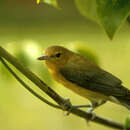en
names in breadcrumbs


A medium-sized (5 ½ inches) wood warbler, the male Prothonotary Warbler is most easily identified by its olive back, gray wings and tail, and bright yellow breast and head. The female Prothonotary Warbler is similar to the male, but is somewhat duller, particularly on the head and breast. The male is unmistakable; the female resembles other female wood warblers, but its combination of yellow breast and gray wings and tail separates it from most, if not all, of its relatives. The Prothonotary Warbler breeds in the eastern United States and southern Canada from Michigan and Ontario south to central Florida and west to Texas. Despite this large range, this species only breeds locally within its range where habitat is appropriate. In winter, Prothonotary Warblers migrate south to southern Mexico, Central America, the West Indies, and northern South America. Prothonotary Warblers breed in wooded freshwater swamps, nesting in abandoned woodpecker nest holes. In winter, this species may be found in tropical wetland habitats, particularly in mangroves. Prothonotary Warblers primarily eat small insects and spiders, but may also eat seeds and other plant material during the winter. In appropriate swampy habitats, Prothonotary Warblers may be seen flitting through the undergrowth or low forest canopy, gleaning insects and spiders from leaves and twigs. Birdwatchers may also listen for this species’ song, a series of metallic “zweet” syllables repeated in rapid succession. Prothonotary Warblers are primarily active during the day, but, like many migratory songbirds, this species migrates at night.